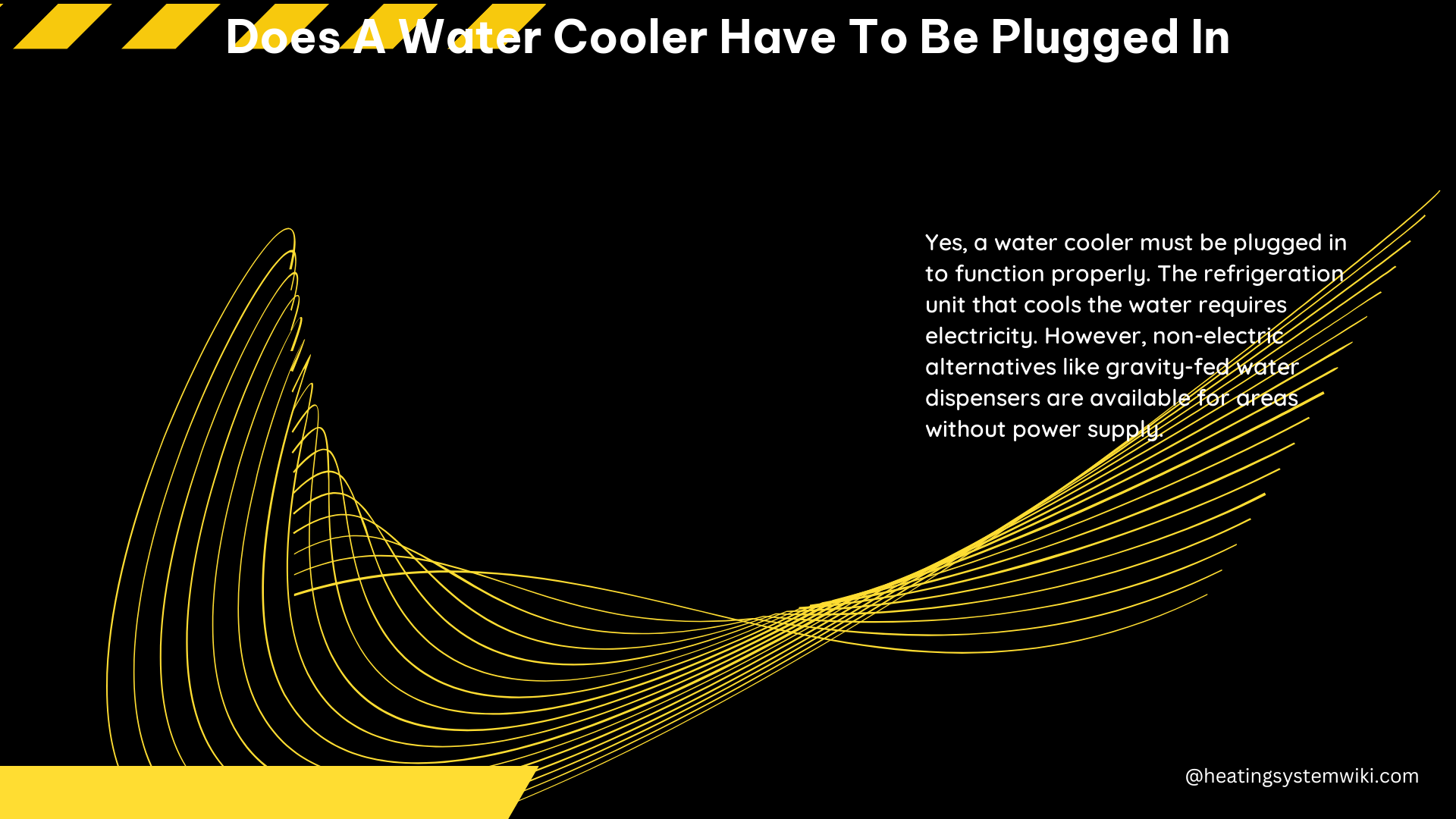Water coolers are a popular appliance for providing clean, chilled drinking water in homes, offices, and other settings. However, many people wonder whether these devices require a power source to function. In this comprehensive guide, we’ll delve into the technical details and explore the various options available for water coolers, including those that don’t require electricity.
The Necessity of Electricity for Water Coolers
The short answer is yes, a water cooler does need to be plugged in to operate. Water coolers rely on an internal refrigeration system to chill the water stored in the tank before it is dispensed. This refrigeration system requires a steady supply of electricity to function properly.
Refrigeration System Breakdown
The refrigeration system in a water cooler typically consists of the following components:
- Compressor: The compressor is the heart of the refrigeration system, responsible for circulating the refrigerant and creating the cooling effect.
- Condenser: The condenser is responsible for dissipating the heat generated by the compressor, allowing the refrigerant to condense into a liquid.
- Evaporator: The evaporator is where the cooling process takes place, as the liquid refrigerant absorbs heat from the water in the tank, causing it to cool down.
- Thermostat: The thermostat monitors the temperature of the water in the tank and controls the operation of the compressor to maintain the desired temperature.
All of these components require a reliable power source to function correctly, which is why water coolers must be plugged into an electrical outlet.
Electricity Consumption Factors
The amount of electricity consumed by a water cooler can vary depending on several factors:
- Features: Water coolers with additional features, such as hot water dispensers or built-in filtration systems, will generally consume more electricity than basic models.
- Usage Frequency: A water cooler that is used frequently will consume more electricity than one that is used infrequently, as the compressor will need to run more often to maintain the desired water temperature.
- Energy Efficiency: Some water coolers are designed with energy-efficient components and features, which can help reduce their overall electricity consumption.
To get a better understanding of the electricity consumption of a specific water cooler model, it’s recommended to check the manufacturer’s specifications or consult with a professional.
Non-Electric Water Cooler Alternatives

While most water coolers require electricity to operate, there are some alternative options available for those who need a water cooler that doesn’t require a power source. These include:
Gravity-Fed Water Dispensers
Gravity-fed water dispensers use the force of gravity to move water from a reservoir to the dispensing spout. These types of water coolers do not require any electricity, making them a suitable option for areas without access to power or during power outages.
Technical Specifications:
– Water reservoir capacity: Typically range from 3 to 5 gallons.
– Dispensing mechanism: Relies on gravity to move water from the reservoir to the spout.
– No electricity required: Operates entirely without the need for a power source.
DIY Tips:
– Regularly check the water level in the reservoir and refill as needed.
– Clean the dispenser regularly to prevent the growth of bacteria.
– Place the dispenser on a stable, level surface to ensure proper water flow.
Ceramic Water Dispensers
Ceramic water dispensers are another non-electric option that uses the natural cooling properties of ceramic to keep the water at a comfortable temperature. These dispensers are often designed with a porous ceramic material that allows for evaporative cooling, eliminating the need for a refrigeration system.
Technical Specifications:
– Water reservoir capacity: Typically range from 2 to 5 gallons.
– Cooling mechanism: Relies on evaporative cooling through the porous ceramic material.
– No electricity required: Operates entirely without the need for a power source.
DIY Tips:
– Keep the ceramic dispenser clean by regularly washing the reservoir and spout.
– Ensure the dispenser is placed in a well-ventilated area to facilitate the evaporative cooling process.
– Refill the water reservoir as needed to maintain the desired water level.
Insulated Water Jugs
Insulated water jugs, also known as thermal carafes or pitchers, are a simple and portable option for keeping water cool without the need for electricity. These jugs use insulation to maintain the temperature of the water, making them a convenient choice for outdoor activities or areas without access to power.
Technical Specifications:
– Water capacity: Typically range from 1 to 3 gallons.
– Insulation material: May use materials like stainless steel, double-walled construction, or vacuum insulation to maintain water temperature.
– No electricity required: Operates entirely without the need for a power source.
DIY Tips:
– Store the insulated water jug in a cool, dry place to prevent the water from spoiling.
– Clean the jug regularly to maintain hygiene and prevent the growth of bacteria.
– Refill the jug as needed to ensure a constant supply of chilled water.
Conclusion
In summary, water coolers do require a power source to operate, as they rely on an internal refrigeration system to chill the water. The amount of electricity consumed by a water cooler can vary depending on its features and usage frequency. However, for those who need a water cooler that doesn’t require electricity, there are alternative options available, such as gravity-fed water dispensers, ceramic water dispensers, and insulated water jugs. By understanding the technical specifications and proper maintenance of these non-electric water cooler alternatives, you can find the best solution to meet your needs.
References:
– Amazon Q&A on Water Coolers
– Reddit Discussion on Water Cooler Operation
– Aqua Cool Blog on Using Water Coolers Without Electricity
